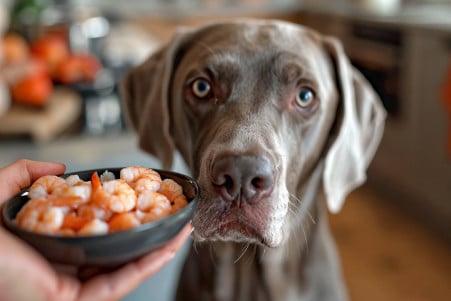Can Dogs Eat Lobster? A Guide to Safe Seafood Consumption
4 March 2024 • Updated 4 March 2024

Lobster is a delicious meal, but can your pup enjoy this type of seafood too? While it’s not recommended as a regular part of a dog’s diet, the short answer is that dogs can eat lobster in moderation. It must be prepared properly, which means it needs to be cooked and free of any seasonings, oils, or butter.
You should also make sure that the lobster meat is removed from the shell to avoid a choking hazard. That said, you should always check with your vet first, especially if your dog has a shellfish allergy.
In this article, we’ll take a deep dive into a range of veterinary recommendations and scientific research on dog nutrition to better understand the potential benefits and risks of feeding dogs lobster. This includes looking at research on dog nutritional requirements, the nutritional content and risks of seafood for dogs, and the likelihood of food allergies, including shellfish allergies.
Through this research, we hope to offer a well-rounded view of whether and how lobster can be included in a dog’s diet and the potential concerns to be aware of.
Can dogs eat lobster?
Lobster for Dogs: Nutritional Value
Lobster is a delicious and nutritious food that can be beneficial to dogs when given as an occasional treat. In addition to being a great source of protein, lobster is also high in important minerals like copper, selenium, and zinc, according to Healthline.
These minerals are important for a dog’s health, helping with enzyme activity and the immune system. Lobster is also high in omega-3 fatty acids, which are good for the heart and can help keep a dog’s coat healthy and shiny.
That said, it’s important to remember that lobster is high in sodium and cholesterol, which can be harmful to dogs if consumed in large amounts. As a result, Hepper recommends that dogs only eat a small amount of lobster, noting that it should be treated as a special treat rather than a regular part of a dog’s diet.
This is consistent with the Association of American Feed Control Officials’ recommendations for a complete and balanced diet, which suggests that lobster should be fed to dogs in moderation.
In spite of its nutritional value, lobster isn’t typically found in dog food. This is largely because it’s expensive and impractical to include in a dog’s diet on a regular basis. Lobster is a luxury, not a necessity, which means it’s more likely to be used as a special treat than a regular food source for dogs.
How to Manage the Risks of Feeding Your Dog Lobster
While your dog may love the taste of lobster, there are several risks and precautions to keep in mind. For one, dogs can be allergic to shellfish, including lobster, just like people. Great Pet Care says that signs of an allergic reaction in dogs include hives, vomiting, and difficulty breathing, and that if you notice any of these symptoms, you should take your dog to the vet immediately.
In addition, dogs can easily choke on lobster shells, so it’s important to make sure that you’ve removed all the shells before feeding it to your pet.
The quality and source of the lobster are also important considerations. As HealthifyMe explains, seafood like lobster can contain heavy metals such as mercury and lead, which can build up in the body and cause toxicity if consumed in large amounts over time.
This makes it especially important to make sure that the lobster you’re feeding your dog comes from a reputable source. In addition, the high levels of sodium and cholesterol in lobster can lead to digestive issues, especially in dogs with preexisting health problems, according to Great Pet Care.
Once you’ve introduced lobster to your dog, it’s important to keep a close eye on them. Pay attention to your dog’s eating and bathroom habits to see if they change after eating lobster. If you notice anything unusual, such as a lack of appetite or diarrhea, contact your vet.
While lobster can be a healthy addition to your dog’s diet in moderation, it’s important to be aware of the risks so that you can make sure that it’s safe for your pet.
How to Balance Your Dog’s Diet: Know the Nutritional Basics
Despite the popular belief that dogs are carnivores, they are actually omnivores that need a well-rounded diet that includes protein, fat, carbohydrates, vitamins, and minerals. According to VCA Hospitals, a well-rounded diet for dogs will include these essential nutrients, and there are certain amino acids and fatty acids that dogs need to get from their diet.
The Association of American Feed Control Officials (AAFCO) has created standards for the nutritional content of commercial pet foods to make sure that they provide a well-rounded diet that meets the nutritional needs of dogs at different life stages.
While seafood, including lobster, can provide some of these essential nutrients, like protein and omega-3 fatty acids, it is not necessary for a dog’s diet. PetMD explains that protein and fat are the most important nutrients for dogs, and while lobster can be a healthy addition to a dog’s diet, it should not replace the basic components of their regular meals.
Feeding your dog lobster as an occasional treat can add some excitement and variety to their diet. However, the Clinical Nutrition Service at Cummings School of Veterinary Medicine at Tufts University stresses that the most important thing is the nutritional content of the food, and that treats, including lobster, should be used to supplement a diet that meets AAFCO’s standards for a complete and balanced diet.
In other words, treats like lobster should be in addition to a dog’s regular diet, which should already include all the nutrients they need to be healthy.
Signs of a Seafood Allergy in Dogs
Seafood allergies in dogs can manifest as a variety of symptoms, from skin irritation to digestive issues. For example, New York Dog Nanny explains that shellfish, including lobster, can cause allergic reactions in dogs, which can result in skin lesions and a decrease in coat quality. If your dog experiences itching, hair loss, or digestive upset after eating seafood, it could be a sign of a shellfish allergy.
According to the VCA Animal Hospitals, the most reliable way to diagnose a food allergy in dogs is with an elimination diet, which typically takes between eight and 12 weeks. During an elimination diet, you remove the potential allergens from your dog’s diet and see if their symptoms improve.
If your dog needs joint support but has a shellfish allergy, there are other options besides glucosamine derived from shellfish. New York Dog Nanny suggests plant-based options, including glucosamine supplements that don’t contain shellfish and that include anti-inflammatory ingredients like turmeric.
As with any new food or supplement, make sure to monitor your dog for any changes in their condition. Look for signs of an allergic reaction, and always talk to your vet before making any changes to your dog’s diet. By slowly introducing new things to your dog’s diet, you can help support their overall health and wellness.
Final Thoughts: Lobster for Dogs
Lobster can be a safe and healthy treat for dogs if given in moderation. It can help increase their protein intake and provide important nutrients like copper, selenium, zinc, and omega-3 fatty acids, which can help improve skin, heart, joint, and brain health, according to MasterClass and Great Pet Care.
That said, it’s important to be careful and talk to your vet before adding lobster to your dog’s diet, especially if your dog has any health issues or food allergies.
While the nutritional benefits of lobster are notable, it’s also important to consider the potential risks. Lobster’s high sodium and cholesterol levels mean it should only be given to dogs occasionally, and the dangers of heavy metals and shell consumption can’t be ignored. To help mitigate these risks, Healthline notes that you should make sure the lobster is prepared correctly and that you control the portion size.
As with any treat, it’s important to be responsible when giving dogs lobster. Part of being a responsible pet owner is making sure you’re making informed decisions about your pet’s diet that prioritize their health and safety. As we’ve discussed, this means that lobster should be an occasional treat in the context of a well-balanced diet.


